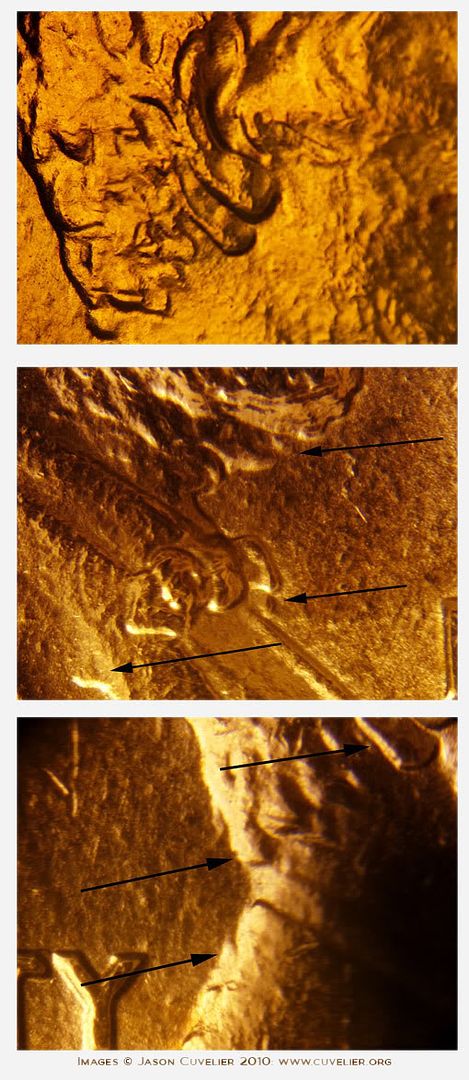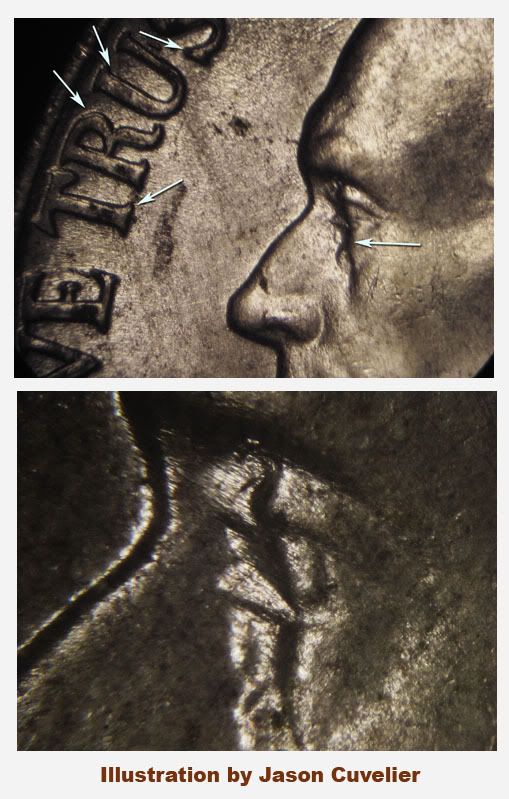This class of Doubled Die is produced when two hubbings have their centers misaligned. It is characterized as having doubling that is evenly spread in one direction unlike Classes I & V where the misalignment-event shows rotation at or near the center (I) or at or near the rim (V). Doubling is often rounded, found closer to the center and when identified on numeric or alphabetic characters, shows notching.
It has been hypothesized that the reason many examples do not show doubling near the rim is because the first hubbing only received a partial hubbing. Such an incomplete hubbing would result in design elements not being pressed deep enough in the middle of the die, and not at all along the perimeters; remember the die originates in a conical shape until it is completely pressed down so the outer devices may not have been hubbed the first time around. A few examples that show doubling primarily in the center portions are 1909P DDO-001; 1941P DDO-005 (1DO-006); 1942P DDO-002 (1DO-005); and 1942S DDO-001
Below is a facsimile of a fictitious 1960P with a strongly doubled Class IV DDO. In this case the first hubbing would have been centered and complete with the second hubbing having its center oriented N-NE from the first. It should be noted that this example is showing universal doubling on all design elements (including the whole portrait) which has never been documented.

Below is 1983P DDR-001, which exhibits a large spread going North, it is stronger than the above hypothetical, but the central elements only show doubling around the parameter of the memorial and in a few sections of the building itself (like the upper portions of the columns). Notice the notching (a clear indication of hub doubling), rounded secondary images and how the secondary hubbing shifts consistently in one direction.

Next we will find two overlays demonstrating that the ’83 DDR has simply a wide north shift in the hubbings. In the second picture green is first hubbing followed by red second (the first hubbing appears as if it were on the first).


Another bold example, yet displaying only a partial first hubbing is 1984P DDO-001, with its widely doubled ear, beard details, back of head and bow tie. This DDO also appears to be ever so slightly rotated as the second piece of the bowtie resides further away proportionally than the second ear. If correct, the center of rotation would be off at least a centimeter to the side of the die past IN of IGWT.


It has been hypothesized that the reason many examples do not show doubling near the rim is because the first hubbing only received a partial hubbing. Such an incomplete hubbing would result in design elements not being pressed deep enough in the middle of the die, and not at all along the perimeters; remember the die originates in a conical shape until it is completely pressed down so the outer devices may not have been hubbed the first time around. A few examples that show doubling primarily in the center portions are 1909P DDO-001; 1941P DDO-005 (1DO-006); 1942P DDO-002 (1DO-005); and 1942S DDO-001
Below is a facsimile of a fictitious 1960P with a strongly doubled Class IV DDO. In this case the first hubbing would have been centered and complete with the second hubbing having its center oriented N-NE from the first. It should be noted that this example is showing universal doubling on all design elements (including the whole portrait) which has never been documented.

Below is 1983P DDR-001, which exhibits a large spread going North, it is stronger than the above hypothetical, but the central elements only show doubling around the parameter of the memorial and in a few sections of the building itself (like the upper portions of the columns). Notice the notching (a clear indication of hub doubling), rounded secondary images and how the secondary hubbing shifts consistently in one direction.

Next we will find two overlays demonstrating that the ’83 DDR has simply a wide north shift in the hubbings. In the second picture green is first hubbing followed by red second (the first hubbing appears as if it were on the first).


Another bold example, yet displaying only a partial first hubbing is 1984P DDO-001, with its widely doubled ear, beard details, back of head and bow tie. This DDO also appears to be ever so slightly rotated as the second piece of the bowtie resides further away proportionally than the second ear. If correct, the center of rotation would be off at least a centimeter to the side of the die past IN of IGWT.








 Be verwy verwy quiet... I'm hunting coins!!!
Be verwy verwy quiet... I'm hunting coins!!! 

Comment